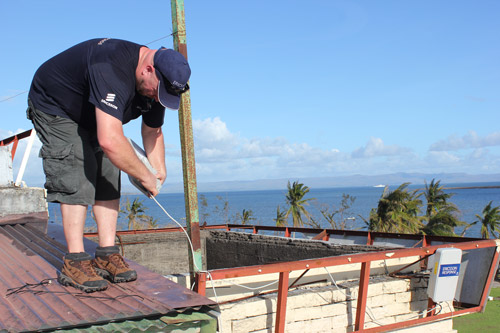
Better, faster, safer internet for humanitarians in the Philippines

Within the first days of the Typhoon Haiyan operation, the Emergency Telecommunications Cluster (ETC) deployed eight personnel from Dubai, Sweden, Canada and Luxembourg; airlifted 300 kilograms of IT equipment from Dubai to the Philippines and provided the humanitarian community in Tacloban, one of the worst hit areas, with basic radio services and internet connectivity.
For the first two days of the operation in Tacloban, internet services were provided using a BGAN satellite terminal. This was subsequently replaced with the ETC Response Solution, comprising technologies from emergency.lu, Ericsson Response and the World Food Programme (WFP).
To distribute connectivity provided by the emergency.lu inflatable GATR antenna, a solution provided by Ericsson Response is used called WIDER, Wireless Internet in Disaster Emergency Response. An engineer from Ericsson, Mike Duffin, is deployed to Tacloban to carry out the installation of WIDER in partnership with the ETC.
"WIDER provides Wi-Fi connectivity for humanitarian workers," explains Mike. "In these types of applications [humanitarian emergencies] there can be fairly limited bandwidth. Using WIDER we can more evenly distribute bandwidth to make it as fair as possible in this situation providing a better level of service."
WIDER requires users to register their details before they access the internet. Once they create their account, they get a limited amount of bandwidth for 24 hours. To extend the time and to get higher – and therefore faster - bandwidth allowance, they will need to confirm their account with the ETC support desk onsite.
"We need a way to distinguish between humanitarians and other users," says Rob Buurveld, WFP FITTEST member currently deployed with the ETC in Tacloban. "We ask them to register so we know who we're providing connectivity to. As the ETC we want to make sure humanitarians get the best ICT services possible to support their work and that the network we're all using to send our operational information remains safe."
The system deployed in the Philippines is WIDER IV which is more environmentally hardened than previous versions of the system. "It can withstand temperatures from -20 to 70 degrees Celsius," says Mike. "It is also packed smaller and all based on Ericsson products which means we can take requirements and turn it around more quickly. We can tune the system for the exact application, which is not the usual [office] application."
In Tacloban, users can access ETC services from City Hall as well as the airport and stadium where the UN On-Site Operations Coordination Centre (OSOCC) has been set up. Additional access points have also been installed to extend coverage to the IHP camp and NGO hall at the stadium. "We're hoping to expand the Tacloban network even more," says Mike. "Additional equipment is coming in from Canada to do that. There are also plans to support four other sites."
An inter-agency ICT assessment conducted in Roxas by representatives from ETC, NetHope and Save the Children, identified the need for internet connectivity for the humanitarian community operating in this area. The ETC is planning to provide shared ICT services including voice and data connectivity and help desk services. Satellite terminals will be provided by NetHope partner British Telecom, and Ericsson Response WIDER will be used to distribute and manage connectivity.
By Mariko Hall, ETC Philippines